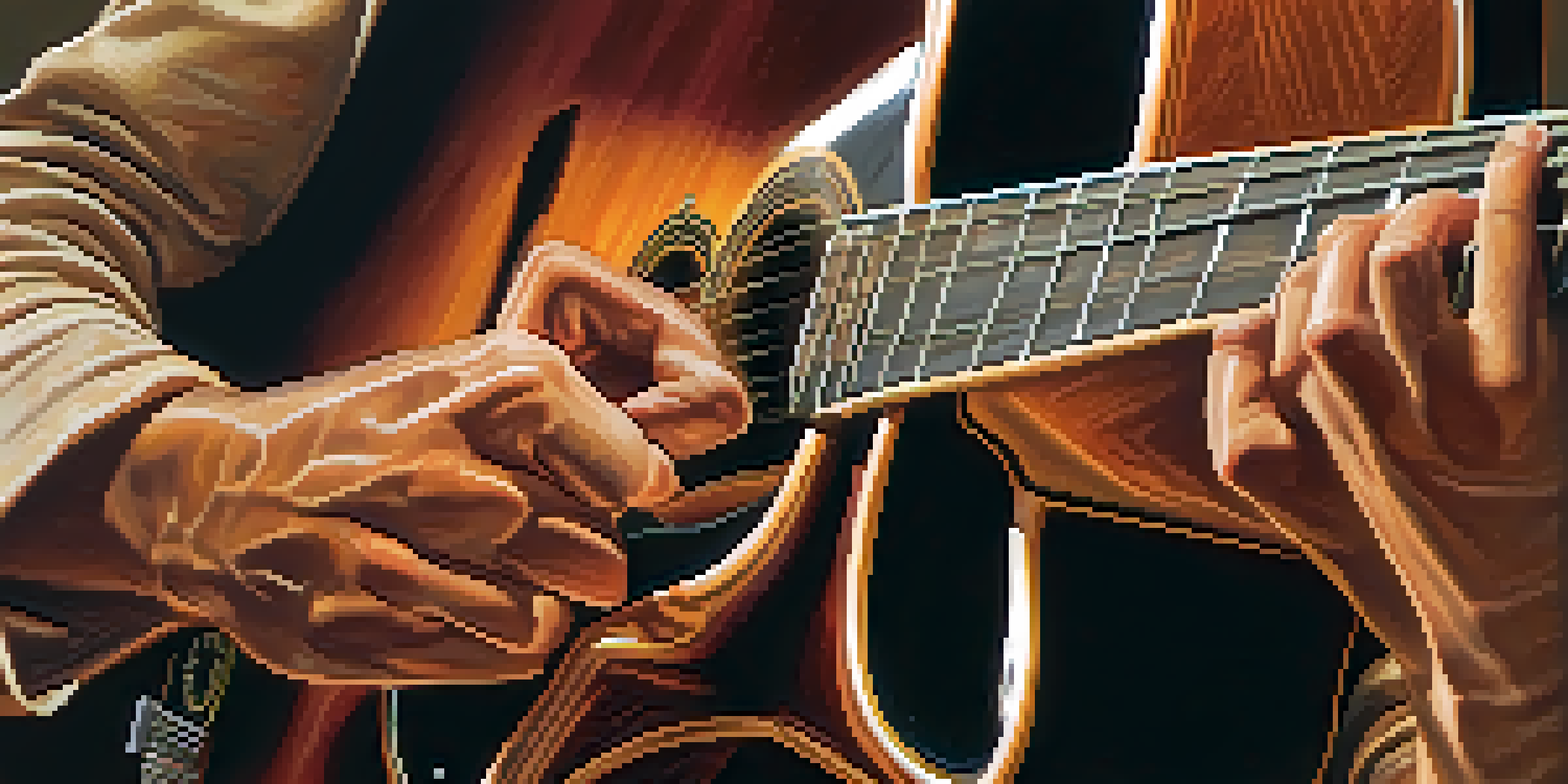Guitar Finger Strength: Key Warm-Up Exercises You Need

Understanding Finger Strength for Guitar Players
Finger strength is crucial for guitarists, impacting your ability to play techniques like bends and slides smoothly. Just like athletes need strong muscles for performance, guitar players benefit from well-conditioned fingers. Building this strength can lead to better control, speed, and overall musical expression.
The only way to do great work is to love what you do.
Many beginners overlook finger strength, focusing solely on chords and scales. However, neglecting this aspect can lead to frustration, especially when trying to master challenging pieces. By incorporating finger exercises into your routine, you can significantly improve your playing experience and enjoyment.
Think of finger strength as the foundation of a house; without it, everything else might crumble. By focusing on developing this strength early in your guitar journey, you'll set yourself up for long-term success and musical growth.
The Importance of Warm-Up Exercises
Warm-ups are to musicians what stretching is to athletes—they prepare your body for the task ahead. Engaging in warm-up exercises helps increase blood flow to your fingers, reducing the risk of injury and enhancing flexibility. This ensures that your fingers are nimble and ready for the demands of playing.

Additionally, warming up can improve your focus and concentration, allowing you to connect with your instrument more effectively. Just a few minutes of dedicated warm-up can make a world of difference in your performance. It’s about setting the right mindset before diving into practice or performance.
Importance of Finger Strength
Building finger strength is essential for guitarists to improve control, speed, and overall musical expression.
Imagine trying to run a marathon without warming up; you'd likely pull a muscle. Similarly, playing guitar without warming up can lead to strain or fatigue, hindering your progress and enjoyment of the instrument.
Basic Finger Exercises to Get Started
One of the simplest yet effective exercises is the finger stretch. Place your fingers on a flat surface and gently press down, spreading them apart. This helps increase flexibility and strength, preparing them for the strings. Practicing this regularly can pay off enormously in terms of dexterity.
Success is where preparation and opportunity meet.
Another great exercise is the spider walk, where you move your fingers across the fretboard in a climbing pattern. This not only strengthens your fingers but also improves your coordination and finger independence. Consistency is key, so try to include this in your daily routine.
Think of these exercises as the warm-up routine for your fingers, much like a musician would warm up their voice before singing. They lay the groundwork for more complex techniques and songs, ensuring you’re always ready to tackle new challenges.
Using a Metronome for Timing and Rhythm
Incorporating a metronome into your warm-up exercises can enhance not just finger strength but your overall musical timing. Start slow and gradually increase the tempo as you gain confidence. This practice helps develop a solid rhythmic foundation, essential for any musician.
Playing with a metronome also trains your fingers to stay in sync with the beat, improving both speed and accuracy. As you practice different exercises, adjust the metronome to challenge yourself and keep your practice sessions fresh and engaging.
Warm-Up Exercises Enhance Performance
Incorporating warm-up exercises increases blood flow, reduces injury risk, and improves focus, setting the stage for effective practice.
Think of the metronome as your personal bandmate, always keeping time and pushing you to improve. By practicing with it, you’ll not only strengthen your fingers but also enhance your overall musicality.
Incorporating Finger Independence Exercises
Finger independence is vital for guitarists, allowing you to play more complex pieces seamlessly. One effective exercise is the 1-2-3-4 exercise, where each finger plays a note in succession on adjacent frets. This simple yet powerful drill helps build strength and coordination across all fingers.
As you progress, try adding variations like playing the exercise on different strings or at different frets. This adds a layer of difficulty, pushing your fingers to adapt and grow stronger. Remember, the more you challenge your fingers, the more proficient you'll become.
Imagine each finger as a team member; if they can’t work together properly, the performance will suffer. Practicing finger independence ensures that each member of this team is strong and capable, leading to a more cohesive and expressive playing style.
The Role of Stretching in Finger Warm-Ups
Just like warming up, stretching is essential for maintaining flexibility in your fingers. Simple stretches, such as pulling back on your fingers gently or creating a 'claw' shape, can alleviate tension and prepare your muscles for playing. This practice can be especially beneficial after long practice sessions.
Regular stretching helps prevent injuries, such as tendinitis, which can sideline your playing for weeks. By incorporating stretches into your warm-up routine, you’re not just preparing your fingers; you’re also safeguarding your ability to play in the long run.
Consistency is Key to Improvement
Establishing a regular warm-up routine helps solidify skills and build muscle memory, leading to long-term growth as a guitarist.
Consider stretching to be the icing on the cake of your warm-up routine. It complements your exercises, ensuring that your fingers are not only strong but also flexible and ready to tackle whatever musical challenges come your way.
Creating a Consistent Warm-Up Routine
Establishing a consistent warm-up routine is key to developing finger strength over time. Aim for a dedicated time each day where you can focus solely on these exercises without distractions. Consistency will help solidify your skills and build muscle memory, making it easier to play in the long run.
You might start with a 10-15 minute warm-up session that includes a mix of stretches, finger exercises, and playing with a metronome. As you grow more comfortable, you can adjust the routine to include more challenging exercises or longer sessions. Personalization is important—find what works best for you.

Think of your warm-up routine as a musical ritual; it sets the stage for a successful practice or performance. By committing to it, you’ll develop not only stronger fingers but also a deeper connection with your guitar.